1966-1974 Saab Sonett: The Forgotten Fiberglass Sports Car From Sweden
Is there a more overlooked classic two-seat sports car than the Saab Sonett? Aimed squarely at the American market from the distant shores of Trollhattan, this unusual race-derived coupe can trace its origins all the way back to mid-1950s, when it was developed by a pair of dedicated enthusiasts within Saab in a bid to break into the racing scene.
Although that effort would be stymied by budgetary and regulatory hurdles, the resulting car would inspire two generations of production vehicles that managed to simultaneously lag the rest of the performance pack in some ways while showing as somewhat ahead of their time in others.
Inauspicious Beginnings
The first Saab Sonett to hit the streets was the Sonett II, which began trickling out to dealers in 1966. To say that the Sonett II was unusual among the existing crop of European sports cars was an understatement: although the vehicle featured a fiberglass body, considered a lightweight, and rust-proof alternative to steel at the time, it was motivated by a two-stroke engine driving the front wheels.

For those unfamiliar with the combustion cycle, all modern automobiles—and indeed, 99 percent of every vehicle on sale in the 1960s—feature a four-stroke design, which delivered smooth and quiet operation. Two-stroke engines, which require a mixture of gasoline and oil to keep the internals lubricated, have traditionally been reserved for the small industrial engines found in chainsaws, lawnmowers and older snowmobiles.
Understandably, Saab's two-stroke Sonett had trouble finding an audience or meeting federal emissions standards in the United States, which was where almost all of the coupes were sent with only a handful reserved for the domestic market. The 3-cylinder unit, which generated a modest 60 horsepower, was eventually replaced halfway through the 1967 model year with a more mainstream 4-cylinder, 4-stroke engine.
Power Bulge
Still a little out of the ordinary due to its V design rather than an inline setup, the Sonett V4 borrowed its drivetrain from Ford of Europe's Taunus sedan. Displacing 1.5-liters, it bumped output by five horsepower and smoothed out the car's driving character. Acceleration remained roughly the same as the original Sonett II, but top speed would climb to just under 100 miles per hour.
While the II was rare, the V4 magnified its build numbers prodigiously as Saab did its best to homologate the car for a number of different racing series. This competition character was evidenced in its standard roll bar as well as body-hugging fiberglass bucket seats and that most Swedish of all inventions, the 3-point seatbelt.

It wasn't until the vehicle's third redesign—the nomenclaturally backwards, but chronologically-correct Sonett III—that the car would enjoy a larger audience. Buoyed by significant success on the track in V4 form, curious sports car fans would descend on Saab dealers in relative droves once the III hit the scene in 1970.
It certainly helped that by now Saab had moved away from the somewhat awkward styling of the V4—with its off-center hood bulged intended to accommodate the chunky engine—and put together a more cohesive, and of-the-times wedge shape for the III. Realizing that perhaps it didn't possess the internal skill set required to tap into the styling zeitgeist, Saab would farm out the Sonett III's looks to Sergio Coggiola, an Italian coachbuilder who would preserve the car's platform while significantly updating its appearance and dramatically improving its aerodynamics. Big, absorbent bumpers would eventually be tacked-on to the coupe near the end of its run.

The new look was in part necessitated by under-the-bonnet changes made to the V4 engine which was again fighting against creeping emissions regs. Performance remained roughly the same despite an increase to 73 horsepower and 87 lb-ft of torque, (although a move to a 1.7-liter engine in 1971 would drop output back down to 65 ponies), and the coupe would continue to do well in SCCA racing thanks in part to its sub-1,800 pounds of curb weight. By the middle of the decade, however, the wind had gone completely out of the Sonett's sails, and the car drove off into the sunset at the end of 1974.
Hidden Gem?
For decades, the Saab Sonett languished as collectors passed it over for more traditional British and Italian coupes and roadsters. Although the two-stroke engine is the rarest of all Sonett drivetrains, its front-wheel drive setup was maintained through its entire lifecycle, which further separated the car from those seeking a front engine/rear-wheel drive experience behind the wheel.

All that together has informed the Sonett's pricing, which remains remarkably affordable compared to its in-era kin. It's one of the cheapest ways to park a classic fiberglass sports car in your garage, and if you can look past the weirdness, you can no doubt also embrace the quirks that make a Saab a Saab and helped define the now-defunct brand's only true crack at building a sports car.
Amazingly, the Sonett wasn't the strangest Saab in history. Click here to see which vehicle claims that dubious honor.











